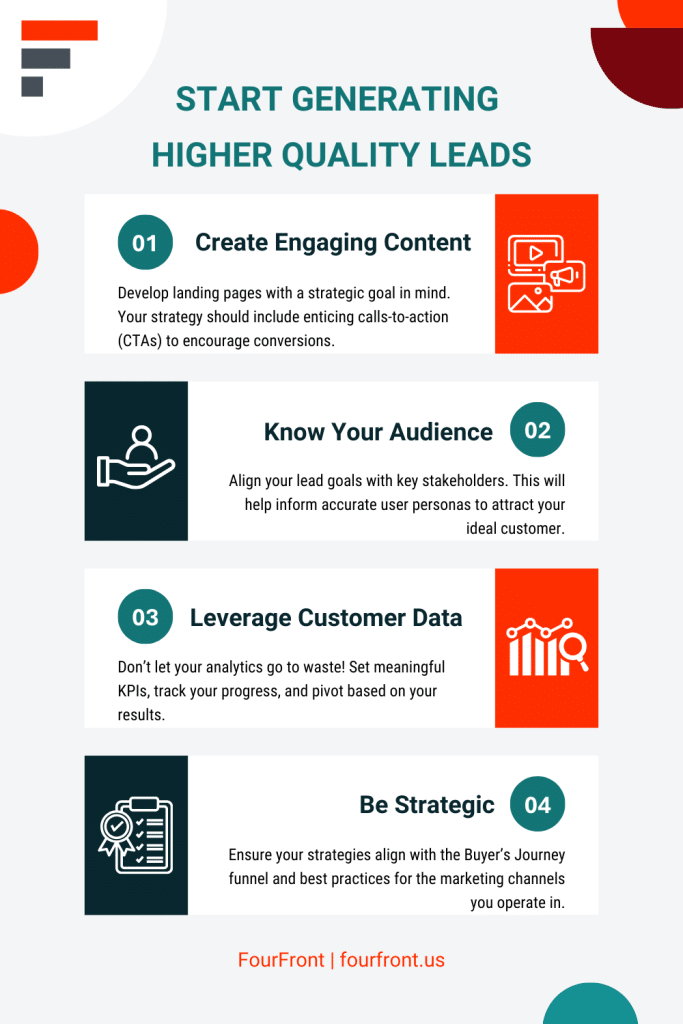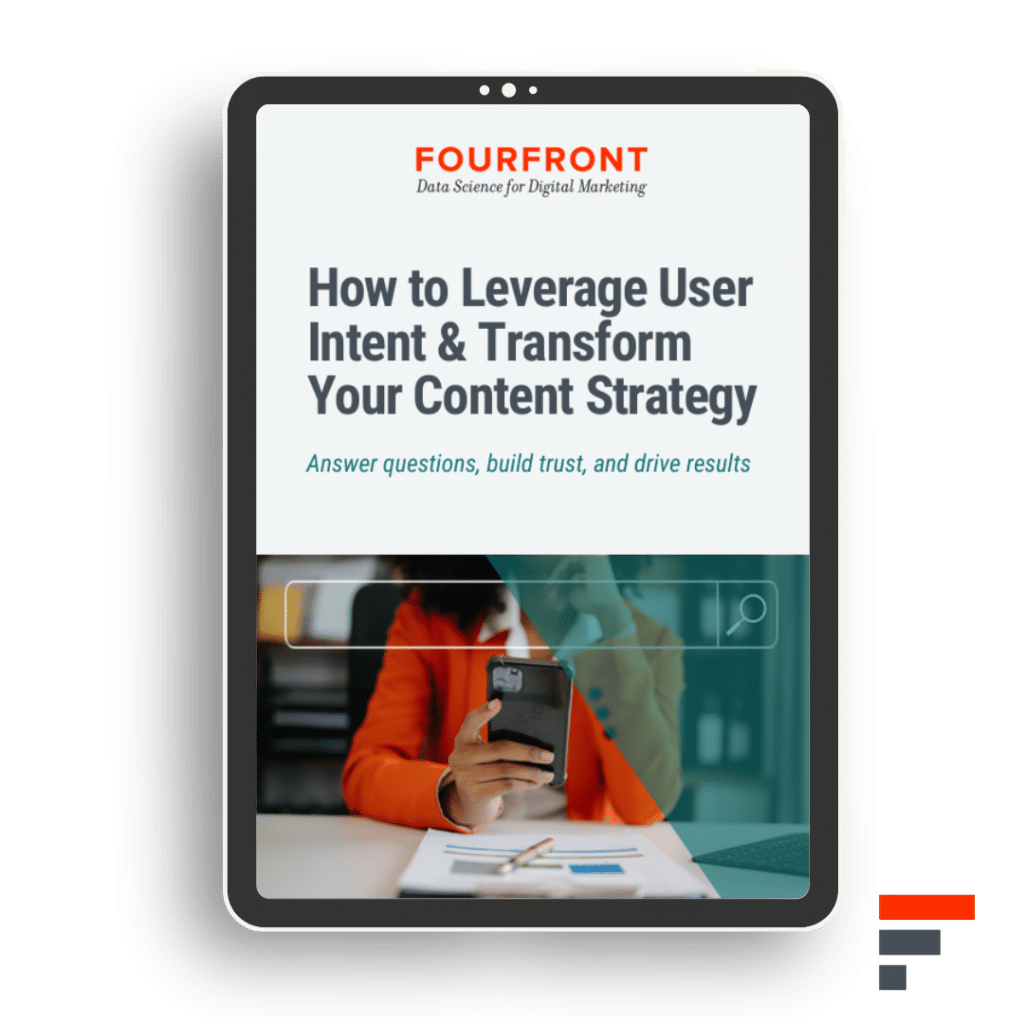More leads don’t always mean more revenue—but better leads do.
Businesses that prioritize lead quality over quantity consistently see higher conversions, lower acquisition costs, and stronger customer retention. So many businesses measure success by volume, but lead quality is what actually drives conversions, reduces wasted effort, and improves ROI.
Poor lead quality has real costs. Marketing teams burn through budgets targeting the wrong people. Sales reps spend days pursuing prospects who’ll never buy. Meanwhile, competitors who focus on qualified leads close deals faster and keep customers longer.
The difference comes down to three things:
- Fit – Does this lead match who you actually serve?
- Intent – Are they showing real buying signals?
- Engagement – Do they interact meaningfully with your content?
Luckily, I’ve got some tried and true strategies for you that fix these issues at every stage—from who you target initially to how you qualify leads before sales gets involved.
Some methods may reduce total lead volume, but that’s kind of the point: fewer, better leads beat a mountain of dead ends.
What is a Quality Lead?
A quality lead is someone who both takes action and shows intent. They complete your CTA—whether that’s booking a demo, downloading a resource, or requesting pricing—and genuinely fit your ideal customer profile.
The difference between good and bad leads comes down to why they act:
- Good leads complete CTAs because they have a real need you can solve
- Bad leads complete CTAs for unrelated reasons (curiosity, freebies, mistaken identity)
Put simply: A quality lead creates more value for your business than they cost to acquire – anything less is just noise in your pipeline.
Why You're Getting Bad Leads
Bad leads aren’t just bad luck—they’re the direct result of measurable problems in your process. The root cause always comes down to one thing: you’re not being picky enough at every step.
Your targeting brings in the wrong crowd because you haven’t defined—and more importantly, excluded—who shouldn’t be seeing your messages. Your content speaks to general problems instead of the specific frustrations your best customers face. Your forms prioritize completion rates over qualification, collecting names instead of intent.
The biggest failure happens when marketing and sales measure different things. Marketing celebrates lead volume while sales suffers through unworkable opportunities. Nobody tracks how many “leads” actually become customers, so the same problems keep happening.
Here’s the hard truth: if you’re not measuring lead quality at every stage, you’re optimizing for failure.
The companies that win track three things meticulously:
- How many leads actually convert to sales
- Why sales rejects leads
- The true cost per sales-ready lead
Without these numbers, you’re just guessing. With them, you can fix what’s actually broken instead of what feels broken.
In the next section, I’ll show you exactly how to implement this—no more theory, just actionable fixes.

How To Generate Higher-Quality Leads
1. Align with the Buyer's Journey
The buyer’s journey has three stages: awareness, consideration, and decision.
- In the awareness stage, prospects realize they have a problem but don’t know the solutions. Use educational content like blog posts or videos to address their pain points and build trust. Folks are unlikely to convert at this stage, so tailor your calls to action (CTAs) accordingly.
- During consideration, leads evaluate options—offer webinars, case studies, or comparison guides to highlight your value.
- At the decision stage, prospects are ready to buy—personalized messaging and offers like demos or consultations help close the deal.
Aligning your marketing and sales efforts with these stages ensures leads stay engaged. Automated email sequences and targeted ads can nurture prospects at every step, guiding them naturally toward a purchase.
2. Score, Segment, and Filter Leads
Lead scoring helps prioritize the best prospects by assigning points based on engagement, demographics, and behavior. For example, visiting a pricing page might earn 10 points, while opening an email earns 2. High-scoring leads are ready for sales outreach, while lower-scoring leads can be nurtured with targeted content.
Segmentation allows businesses to tailor messaging for different lead groups. High-priority prospects might receive personalized demos, while lower-intent leads get educational resources. Use CRM tools and automation to set filters that disqualify mismatched leads early—such as blocking personal email addresses or irrelevant job titles—and route qualified leads to the right sales reps automatically.
3. Use Landing Pages Strategically
A well-designed landing page improves lead quality by delivering the right message to the right audience.
Clear, compelling headlines should immediately communicate the value of your offer, while trust signals like testimonials or client logos build credibility. Having lead forms on key landings pages is a great strategy. Keep forms simple but effective—ask only for essential information like name, email, and company size to avoid overwhelming prospects. More on optimizing your forms later.
A/B testing is key to refining your landing pages. Experiment with CTA wording, form fields, and page layouts to see what drives the most qualified leads. For example, test whether a shorter form increases conversions without sacrificing lead quality or if a video explainer outperforms static text in engaging visitors.
4. Improve Ad Targeting to Reduce Low-Quality Leads
Refining audience targeting in paid ads ensures your campaigns reach the right people.
Platforms like Google Ads, Facebook, and LinkedIn allow you to narrow audiences through interest-based, behavioral, and firmographic filters.
- Interest-based: what is my audience interested in?
- Behavior: what actions, behaviors does my audience engage in?
- Firmographic: what are the different traits of businesses in my target audience? Industry, company size, location, etc.
For example, LinkedIn ads can target decision-makers by job title and company size, while Google Ads can focus on “in-market” segments actively searching for solutions.
Avoid wasting budget on irrelevant clicks by disabling extended ad networks that display ads on low-quality sites. Precise targeting—such as excluding students or unrelated industries—reduces low-quality leads and improves conversion rates.
5. Identify Key Decision-Makers
Focusing on decision-makers ensures your efforts target people who can actually move deals forward.
Use LinkedIn to identify prospects with titles like “Director” or “VP” and verify their authority through tenure or role descriptions. CRM data can help flag leads with relevant keywords in their job titles, while personalized outreach—such as referencing specific challenges in their industry—builds credibility and engagement.
To avoid wasting time on non-decision-makers, verify lead information early. Look for professional email addresses instead of generic ones and ask qualifying questions like, “Are you responsible for purchasing decisions?” This helps ensure your pipeline is filled with leads who have the authority to act.
6. Focus on the Ideal Buyer Persona
Defining and refining your ideal buyer persona ensures your marketing speaks directly to the right audience.
Start by identifying key traits like industry, company size, demographics, and specific pain points your solution addresses. For example, your ideal customer might be mid-sized manufacturers struggling with supply chain inefficiencies.
Track engagement data to refine personas over time. Analyze which leads convert most often and identify patterns in their behavior or attributes. Regularly update your personas based on real-world results to ensure your campaigns stay aligned with the prospects most likely to buy.
7. Create Engaging CTAs
Well-crafted calls to action (CTAs) improve lead quality by encouraging prospects to take meaningful steps toward conversion.
Weaker CTAs like “Learn More” or “Click Here” often attract curiosity rather than intent, while action-oriented language such as “Request Your Free Demo” or “Get Your Custom Quote” makes the next step clear. Test out adding urgency with phrases like “Limited Spots Available” and social proof such as “Join 1,000+ Industry Leaders” to build trust and drive engagement.
Test different CTA placements, colors, and formats to see what resonates with your audience. For example, a sticky CTA bar might outperform a button at the bottom of the page, while bold colors can draw more attention than subtle ones. Refining these elements ensures your CTAs attract leads who are ready to act.
8. Leverage Data Analytics and Automation
Tracking lead behavior, engagement levels, and conversion trends is essential for refining your lead generation strategies.
Analyze metrics like time spent on key pages, email open rates, and content downloads to identify high-intent prospects. For example, leads who revisit your pricing page multiple times are more likely to convert than those who bounce after viewing a blog post.
Automation tools like HubSpot, Salesforce, and Google Analytics streamline lead qualification by scoring leads based on their actions and demographics. CRM integrations can automatically route high-priority leads to sales while nurturing lower-intent prospects with email sequences tailored to their behavior. Using these tools ensures your efforts focus on the leads most likely to convert.
9. Choose Keywords and Targeting Wisely
High-intent keywords are critical for attracting leads who are ready to convert.
Terms like “custom parts supplier” or “precision engineering services” signal strong buying intent compared to broader phrases like “manufacturing solutions.” While high-volume keywords may bring more traffic, high-intent keywords often deliver better results by targeting prospects further along the buyer’s journey. Use tools like Google Keyword Planner to refine your strategy based on search intent, search volume, and competition, prioritizing terms that align with your ideal customer’s needs.
Precise targeting improves lead quality even further. Apply geographic filters to focus on regions where your services are most relevant and incorporate industry-specific keywords to narrow your audience. Negative keyword lists—such as excluding terms like “free” or “DIY”—help eliminate irrelevant traffic, ensuring your campaigns reach serious buyers actively searching for solutions. These strategies help connect your ads (and your keyword targeting strategies) with qualified prospects who are more likely to convert.
Don't spend another minute creating content no one wants.
Even with all the shiny new AI tools, creating content takes valuable time.
Our FREE Guide to Leveraging User Intent will help you stop guessing and start creating the content your audience is looking for.
Get it in your inbox now.
Don't spend another minute creating content no one wants.

Even with all the shiny new AI tools, creating content takes valuable time.
Our FREE Guide to Leveraging User Intent will help you stop guessing and start creating the content your audience is looking for.
Get it in your inbox now.
10. Optimize Lead Forms for Better Conversions
Your lead forms are one of the most critical tools for capturing high-quality leads while filtering out unqualified prospects.
For B2B businesses, requiring work emails instead of personal addresses (like Gmail or Yahoo) can help eliminate spam and ensure you’re engaging with legitimate companies. However, in industries where personal emails are common, this filter may not be appropriate—adjust your approach based on your audience. Adding qualifying questions like “What is your company size?” or “Which industry do you operate in?” gives you immediate insight into whether a lead fits your ideal customer profile.
Verification steps such as demo requests or phone confirmations further ensure serious interest. For example, asking leads to schedule a call or provide additional details about their needs can weed out casual browsers. Testing form length and fields is equally important—short forms may increase conversions but risk attracting lower-quality leads, while longer forms can improve lead quality but reduce submissions.
Striking the right balance through A/B testing will help you optimize both conversion rates and lead quality.
11. Keep Email Lists Clean
Maintaining a clean, high-quality email list is essential for effective lead nurturing.
Regularly remove inactive subscribers—those who haven’t opened or clicked an email in 90 days—to ensure your campaigns focus on engaged prospects. Verifying email addresses before adding leads to your list helps prevent bounces and keeps your sender reputation intact.
Segment your list based on engagement levels to tailor your outreach. Active leads can receive high-touch nurturing campaigns, while less engaged contacts might benefit from re-engagement emails like “Still interested in [specific solution]?”
A clean email list improves deliverability, ensures better targeting, and maximizes the impact of your lead nurturing efforts.
12. Set and Track KPIs
This might actually be the most important point in this whole post. Establishing and monitoring key performance indicators (KPIs) is critical for measuring lead quality and optimizing your lead generation efforts.
Focus on metrics that directly reflect success, such as conversion rates (lead-to-customer), cost per qualified lead, and the lead-to-customer ratio. These KPIs help you understand which strategies are delivering high-quality leads and which need adjustment.
Continuously refine your tactics based on performance data. For example, if your cost per qualified lead is rising, analyze whether your targeting is too broad or your messaging needs improvement. Regularly reviewing KPIs allows you to allocate resources to the most effective channels and ensure your pipeline remains filled with leads that convert.
Reset Your Lead Quality vs. Quantity Expectations
Focusing on lead quality over quantity may feel counterintuitive at first, especially if you’re accustomed to measuring success by the sheer number of leads generated.
However, prioritizing quality leads—those who align with your ideal customer profile and are more likely to convert—will ultimately save time, reduce wasted resources, and drive higher ROI. While your total lead volume may initially decrease, the percentage of high-value prospects in your pipeline will grow, leading to better long-term results.
To make this shift successfully, start by setting a minimum acceptable lead volume that aligns with your business goals. For example, if your sales team needs 20 qualified leads per month to hit revenue targets, use that as a baseline while optimizing for quality. This ensures your pipeline remains active while you refine your targeting and qualification processes.
Tracking performance metrics is essential for fine-tuning your strategy over time. Set and monitor KPIs like cost per qualified lead, lead-to-customer conversion rates, and sales cycle length to evaluate the impact of focusing on quality. If you notice a drop in lead volume but a significant improvement in conversion rates or deal sizes, it’s a sign that your efforts are paying off. Use this data to continuously adjust your campaigns, balancing quality improvements with maintaining enough volume to support growth.
At the end of the day, resetting expectations around lead quality vs. quantity requires a mindset shift: success isn’t about attracting as many leads as possible. It’s about attracting the right leads who are ready to engage and convert into loyal customers.
Improve Lead Quality Today for Stronger Sales Tomorrow
Improving lead quality builds the foundation for sustainable growth. High-quality leads convert at higher rates, shorten sales cycles, and lead to stronger customer relationships. By focusing your efforts on prospects who genuinely need your solution, your marketing and sales teams can work more efficiently and drive better results.
The time to act is now. If you’re feeling overwhelmed by the idea of overhauling your whole process, start by just revisiting your lead forms—add qualifying questions like company size or industry to ensure you’re attracting the right prospects. Then refine your targeting criteria by excluding irrelevant segments and focusing on high-intent keywords. These small changes will help you take the first step toward building a pipeline filled with high-quality leads.
Are you still feeling daunted by this whole process? We can help. Set up a free consultation today (see that strong CTA?) and find out how FourFront can help you start getting better leads.













